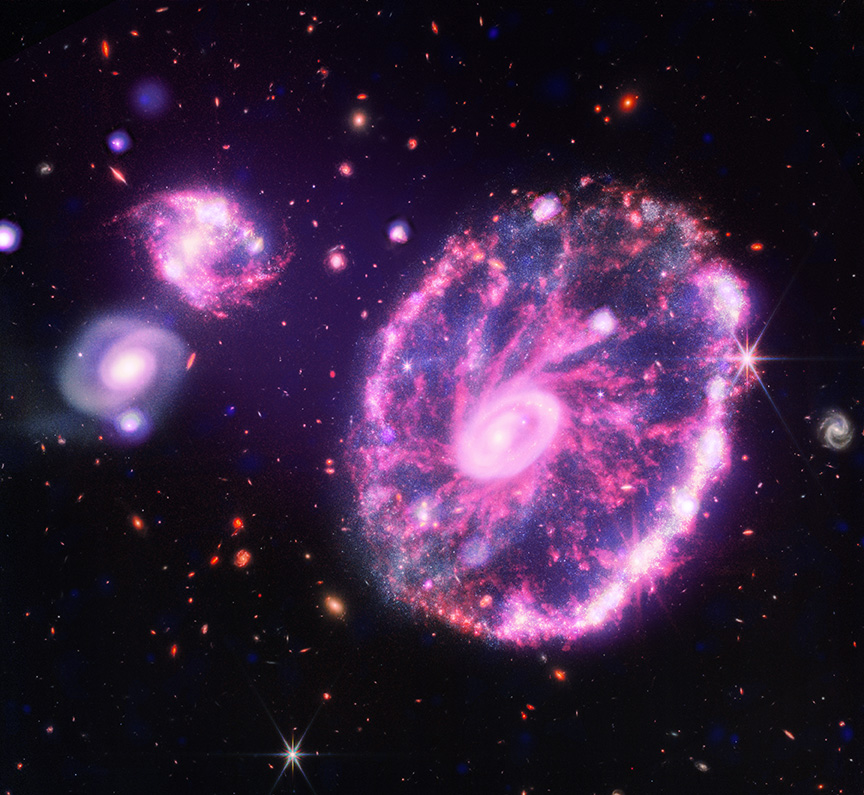Find out the latest thinking about our universe.
-
bystander
- Apathetic Retiree
- Posts: 21577
- Joined: Mon Aug 28, 2006 2:06 pm
- Location: Oklahoma
Post
by bystander » Tue Oct 25, 2022 2:59 pm
 HEAPOW: Doing Cartwheels (2022 Oct 24)
HEAPOW: Doing Cartwheels (2022 Oct 24)
The Universe can be a fairly crowded place if you're a
galaxy. Galaxies like to cluster with other galaxies, which means that a neighboring galaxy may not be too far away. This proximity, and the mutual
gravitational attraction one galaxy feels for another, mean that
collisions between galaxies are fairly common, and one of the normal ways in which galaxies grow and change. The image above shows the Cartwheel galaxy, perhaps the most famous result of a galaxy collision. The Cartwheel started out as a mundane
spiral galaxy similar to the Milky Way, but, a hundred million years ago or so, a smaller galaxy hit it near dead center. This collision createed an enormous circular shock which rippled outwards from the point of collision, compressing gas in its wake and sparking a ring of stellar birth at the outer edges of the galaxy. The image above is composite of an X-ray image (in purple) from NASA's
Chandra X-ray Observatory and a cool infrared image from NASA's brand new
James Webb Space Telescope. The X-ray image highlights the hot shocked gas produced by the long-ago collision, some of which has
splashed more that 150,000 light years from the galaxy. The infrared image highlights the emission from starburst regions in the Cartwheel. The images also show unrelated galaxies, some of which are also X-ray sources, along with X-ray sources invisible to JWST.
Chandra Adds X-ray Vision to Webb Images
Know the quiet place within your heart and touch the rainbow of possibility; be
alive to the gentle breeze of communication, and please stop being such a jerk. — Garrison Keillor
-
bystander
- Apathetic Retiree
- Posts: 21577
- Joined: Mon Aug 28, 2006 2:06 pm
- Location: Oklahoma
Post
by bystander » Tue Nov 22, 2022 7:02 pm
Chandra Adds X-ray Vision to Webb Images
NASA | MSFC | SAO | Chandra X-ray Observatory | 2022 Oct 04
In the summer of 2022, NASA's James Webb Space Telescope released images from some of its earliest observations with the newly commissioned telescope. Almost instantaneously, these stunning images landed everywhere from the front pages of news outlets to larger-than-life displays in Times Square.
Webb, however, will not pursue its exploration of the universe on its own. It is designed to work in concert with NASA's many other telescopes as well as facilities both in space and on the ground. These new versions of Webb’s first images combine its infrared data with X-rays collected by NASA’s Chandra X-ray Observatory, underscoring how the power of any of these telescopes is only enhanced when joined with others. ...
Cartwheel Galaxy: The Cartwheel galaxy gets its shape from a collision with another smaller galaxy — located outside the field of this image — about 100 million years ago. When this smaller galaxy punched through the Cartwheel, it triggered star formation that appears around an outer ring and elsewhere throughout the galaxy. X-rays seen by Chandra (blue and purple) come from superheated gas, individual exploded stars, and neutron stars and black holes pulling material from companion stars. Webb’s infrared view (red, orange, yellow, green, blue) shows the Cartwheel galaxy plus two smaller companion galaxies — not part of the collision — against a backdrop of many more distant galactic cousins. ...
Know the quiet place within your heart and touch the rainbow of possibility; be
alive to the gentle breeze of communication, and please stop being such a jerk. — Garrison Keillor
 HEAPOW: Doing Cartwheels (2022 Oct 24)
HEAPOW: Doing Cartwheels (2022 Oct 24)
